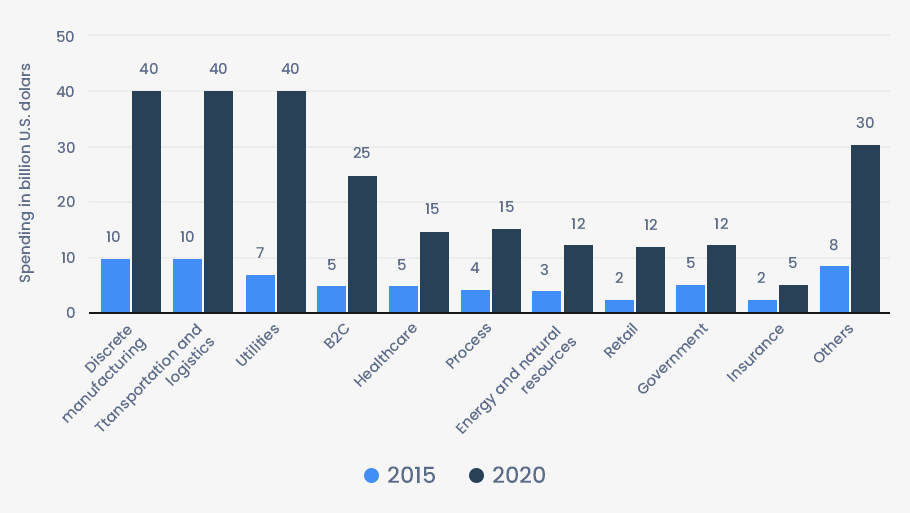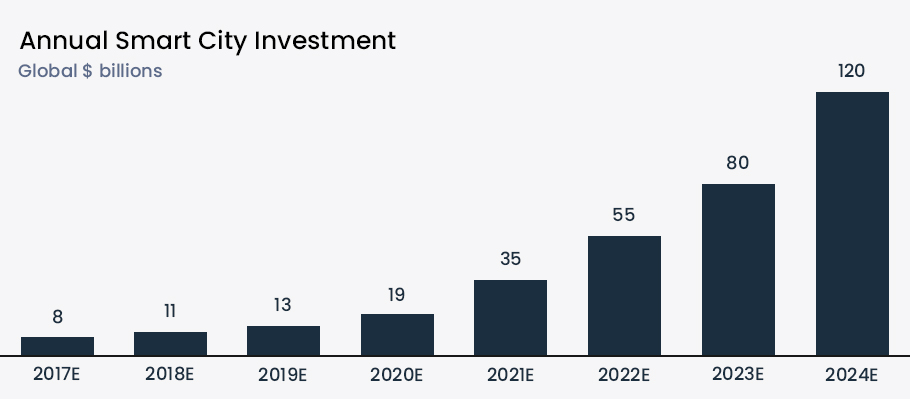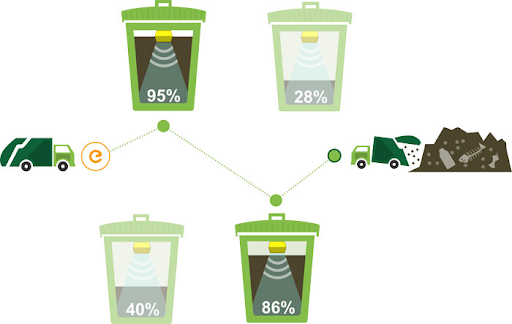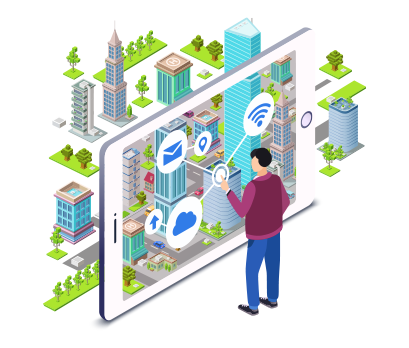Imagine a downtown street. There’s Sam, going grocery shopping in his wheelchair. At the crossroad, he switches on a specific light to safely cross the street.
On the other street where the city mall is, Robin can find a real-time parking spot via his phone.
Meanwhile, there is some hustle in the police station because the gun detection sensors have sent danger notifications. Immediately cops rush to the spot.
That’s great, isn’t it?
IoT smart city is no longer the future. They are here. Making our lives better, and safer.
Thank IoT for this!
This giant network has the power to connect and improve infrastructure, improve the quality of life for citizens, and promote sustainable development.
In this article, we will discuss the contribution of IoT in smart city.
Keep reading!
Here’s what we’ll cover:
- IoT: Current and Future Landscape
- How is IoT Making Cities Smarter
- IoT in Smart City – Common Use Cases
- A Guide to Implementing IoT Smart City Solutions
- Smart City Monetization
IoT: Current and Future Landscape
Just like we talk with each other’ in the digital world, we can make physical objects communicate. In simplified terms: a multiple of physical objects like your phone, car, refrigerator, streetlights, and so on are connected to the internet. It allows you to send, receive, and interpret data. Thus, enabling you to communicate with other physical things.
And IoT refers to billions of such objects connected to the internet, all sharing and collecting data. A smart thermostat, for instance, receives location data from your smart car which it uses to adjust your home’s temperature before you arrive.
Statistics say that in 2019, the number of active IoT devices reached 26.66 billion which will reach a whopping 75 billion by 2025.
The Internet of Things market size is so big, it has the potential to generate $4 trillion to $11 trillion by 2025. (McKinsey Global Institute). Have a look at IoT spending worldwide.

IoT current trends are visible across all existing industries- healthcare, insurance, smart buildings, manufacturing, transportation & logistics, retailing, and more. From real-time cargo monitoring to managing medical equipment, it is now possible to manage and monitor every activity which was previously unreachable.
Here are some of the IoT in smart city trends that you need to know.
- Artificial Intelligence: AI and data analytics is helping to make reliable predictions. Secondly, AI enabled IoT creates intelligent machines that simulate smart behavior with little or no human interference. Self-driving cars are the best example of IoT and AI working together. With the help of AI, self-driving cars predict the behavior of pedestrians and can determine road conditions, optimal speed, etc. In this way, AI enabled IoT boosts operational efficiency, increases scalability, and helps with risk management.
- Blockchain Technology: Blockchain technology is a major IoT tech trend. Blockchain provides an infrastructure that allows the exchange of money and data between IoT devices. These transactions guarantee anonymity and security to multiple networks and owners. The three advantages of blockchain for IoT are: (a) build trust between parties and devices and reduce the risk of tampering, (b) reduce costs by removing middlemen, (c)facilitate quick transactions.
- 5G Networks: With 5G, data transfer speed increases significantly. This increase in speed enables IoT devices to share data faster than ever. Be it devices for healthcare or home appliances, there is a drastic improvement in speed. Moreover, greater network reliability creates more stable connections which are extremely important for any IoT smart city.
- Edge computing: Edge Computing is a distributed computing paradigm where you can carry out processing and computation on classified device nodes known as smart devices/edge devices as opposed to a centralized cloud environment or data centers. You can process the data produced by the Internet of Things devices with the help of edge computing. This improves time to action and reduces response time.
How is IoT Making Cities Smarter
The influx of new residents in urban areas is primarily for a good life. The UN predicts that by 2050, the world’s urban population is likely to double and reach the point of nearly 6.7 million people.
But the hike in population results in several challenges– traffic, environmental problems, increase in crimes, sanitation problems, etc. To tackle them and to create economic growth, usage of IoT in smart city is growing.

(Image Source)
IoT devices are becoming a part of IoT smart city infrastructure to help attain environmental, social, and economic sustainability. IoT enabled traffic lights turn green if the road is clear. Sensors help optimize the bus route. These kinds of data-driven environments improve efficiency and reduce cost.
For example, in the IoT smart city South Korea, smart sensors reduced building costs by a third by monitoring water and electricity usage, according to Harvard Business Review.
But what makes a city smart? Smart cities use data and intelligent solutions to make cities smarter and improve the quality of life. Comprehensive, real-time data gives agencies the ability to observe the events, understand how demand patterns change, and respond with quicker and cost-effective solutions.
There are three layers you need to understand when building IoT smart city. First is technology which includes a network of connected devices and sensors. Second includes smart applications and data analytics which translates raw data into alerts and insights. Based on these insights, several actions are taken with the help of right tools and solutions which technology providers or app developers provide. The third layer includes adoption and usage by cities and the public.
Smart doesn’t only mean using technology to streamline operations and enhance the infrastructure. It includes the decisions to deliver a better quality of life. There are several aspects to it. For example, providing clean air and water to citizens, shorter commutes, providing a safe environment on the streets, a reduced health burden, and more.
Are you still confused if IoT smart city solutions can be efficient?
IoT in Smart City – Common Use Cases
1. Transportation
Smooth and quick transport is of growing importance in most cities. Transportation in an IoT smart city includes information systems that collect data about traffic, vehicles, and usage of different modes of transport. These information systems optimize and regulate traffic, public transport, parking facilities, etc. thus making transportation efficient and accessible for residents. The important elements of smart transport are:
-
- Advanced Traffic Management System (ATMS)
Having an ATMS in IoT smart city helps collect information from GPS, toll booths, traffic lights, car parks, and smart roads. Based on the data collected, the sensors can alter the traffic light in real-time to prevent congestion, send drivers information about traffic conditions or speed.
-
- Smart parking
Smart parking solutions help the driver find a parking spot easily instead of the driver driving around to find a place. How does this work? Parking spots have sensors embedded. These sensors determine if there is a free spot and create a real-time parking man. The driver gets a notification and using the map, he can find the location.
Some IoT-enabled sensors interact with smart vehicles to gather data to determine the location of free space available. While other sensors use vehicle feedback to tell where the openings are.
-
- Accident Awareness
In IoT smart city, if a car meets with an accident, the driver can immediately share the location with the authority. Smart transits enable them to do so. These transits even send notifications to smart car drivers if they are driving at a high speed. Some smart transit tech takes accident prevention even further. IoT -enabled sensors that monitor the condition of the road, help to reroute the traffic when road maintenance lags.
Here are few examples of smart transportation in popular cities:
#1 The New York City Department of Transportation’s Midtown in Motion is a congestion management system that has improved travel times on Midtown’s avenues by 10%.
#2 IoT smart city Barcelona uses wireless sensors beneath roads that notify drivers about vacant parking space via an app. This app also allows users to pay for parking and supplies parking data for use by different smart city systems.
#3 Copenhagen, one of the smartest cities in the world, has a smart bike system where embedded sensors provide real-time information to both the riders and administrators. The officials then use the data to monitor and manage air quality and traffic congestion.
2. Waste Management
In the traditional approach to waste management; waste collecting trucks will collect the waste from every house in every street. This approach is not efficient for the simple reason that it’s time consuming. IoT in smart city helps in optimizing the schedules for waste collection by tracking waste levels. Every waste container comes with a sensor that gathers data on the waste level. When the level reaches a certain level, the waste management provider will receive a notification after which the driver comes to collect the waste. This saves both time and fuel.
Denmark, a smart city using IoT, includes intelligent waste monitoring for which SmartBin has deployed its sensors to a range of waste and recycling containers integrated with the City Digital Platform.

3. Safety
Corporations of every IoT smart city aims to ensure the safety of every citizen. They deploy some forms of analytics solutions and video surveillance like CCTV cameras to detect situations like accidents, crimes, or potential threats. These solutions come with a face recognition feature that helps the police to stop and track perpetrators. These tools are highly efficient in crowded areas where security professionals cannot observe every information all the time.
Some smart cities, like Denver, are turning to acoustic gunshot detection systems (AGDS) to enhance public safety. Denver police estimate that AGDS has contributed to 134 arrests since it was implemented.
Saudi Arabia adopted a nation-wide emergency SMS alert system that uses mobile GPS to alert individuals when they are in dangerous areas or near emergency scenarios.
Get free consultation for IoT smart city solution:
4. Utilities
Smart technologies provide cities with the tools that help to conserve and reduce the wastage of utilities like water and electricity. It even allows citizens to save money by giving them control over home utilities.
Smart sensors quickly identify leaks in the pipes and fix the damaged part within a short time. This helps to reduce the amount of water loss.
Smart meters by sending data to the utility provider allows them to bill accurately for the amount of water or gas every household consumes. They play an essential part in tracking the utility. If the usage increases, you can take further actions.
Examples:
#1 Cape Town is a good example which uses smart metering technology to combat the water crisis. These meters track water usage for customers and relay the data to their accounts. The citizens of this IoT smart city then receive a bill that displays their water consumption. After adopting this method, there was a nearly 40%-60% drop in the level of water consumption.
#2 Castellon in Spain has 30,000 smart water meters that can communicate with each other and adjust the flow as necessary to remain efficient while requiring much less energy than normal meters function.
Related: IoT Fleet Management: The Roadmap to Success
5. Environment
Environmental changes are affecting every city around the globe. It is increasingly becoming necessary to tackle global warming, greenhouse gas emissions, debris in the sea, and waste on the streets. To protect the environment, IoT smart cities are using solutions like air-quality sensors, energy-efficient buildings, and renewable resources. Air quality sensors, for example, help to track low-quality air and identify its causes thus helping in reducing pollution. They even deploy sensors in the water grid. These sensors store data of chemical composition in the water and if there seems to be an imbalance, the water management solution will receive a notification and the field workers will start their job of fixing it.
6. Healthcare
The goal of smart cities is to improve the quality of life. And what’s better than providing smart health solutions to citizens. Smart health includes digital technologies for health monitoring and diagnostics, improving the lifestyle of people with chronic diseases, etc. IoT provides emergency services with new tools to improve their response time to emergencies.
Remote patient monitoring is one example of smart healthcare. The embedded sensors detect blood and glucose levels in patients, and send the data to doctors who analyze all the data to prescribe treatment and medicines.
Have a vision for IoT smart city? It’s time to turn your vision into a solution.
A Guide to Implementing IoT Smart City Solutions
Every IoT smart city application has a common approach to implementation. While designing the architecture for an IoT smart city, it is important to have a clear vision of the environment and the people who live in the city. Having said that, Let’s discuss the three steps of IoT smart city architecture.
Step 1: IoT Smart City Platform
In this step, we will define the basic elements required to build a smart city using IoT.
- Things: A thing is any physical object with sensors that gathers data and transfers it over the network. A smart city uses smart things like street lights, traffic lights, buildings, cars, etc. to collect data and send it to cloud management platforms– sensors installed in waste containers measure the amount of waste, sensors on road measure the average traffic speed, etc.
- Gateway: It serves as a medium between the smart thing and cloud platform. They facilitate data gathering and compression by preprocessing and filtering data before moving it to the cloud.
- Data Lake: It’s a place used for storing the data generated by the device in its natural state. When needed, you can extract the data from the lake and send it to the big data warehouse.
- Big Data Warehouse: It contains structured data as well as information about the place where sensors are located and what’s the control command that applications send to smart things.
- Data Analytics: Data analysts use analytics solutions to check the sensor data and extract meaningful insights. Data visualization tools; in the case of IoT smart cities, you require tools to monitor traffic, identify crimes, etc. which help in easy analysis of the data. By integrating these tools and data analysis into dashboard applications, you can display the required data on a single screen and can even update it when new information is available. E.g.: with the help of a data analytics tool for monitoring traffic, it is possible to reveal patterns of traffic and further make efforts in tackling it.
- Machine Learning: Machine learning, by using advanced techniques can help adapt the behavior of smart things to the requirements of city residents. This is because machine learning algorithms can reveal hidden correlations. Based on these correlations, you can build predictive methods that tell how connected things will connect to particular situations. Control applications use these models to send commands to objects/things. For instance, you can use ML to manage traffic. ML algorithms will help create patterns of traffic distribution, detect areas with heavy traffic, etc. and based on that make adjustments in light timings or re-route traffic.
- Control applications: They send commands to things’ actuators. They can either be rule-based- use rules programmed manually or Machine learning-based- use the models that we talked about in the previous point. For example, actuators of a streetlight can receive a command to brighten the lights when any suspicious movement takes place on the streets.
- User applications: They enable the citizens to send commands or receive alerts to control applications. For instance, user apps will receive notifications for an empty parking spot. The user can also use the app to view the map of parking spots, register his car for the spot and pay for parking.
Step 2: Service Management Solution
You notice that a traffic light is not working. You click its picture, add information about the location, and send the report on a mobile application. Service management solution will receive an alert, process it, create a case and notify the field worker. He comes to the location with his team, fixes the problem, and is done!
In this way, the service management solution plays an important role in providing timely support to the citizens by addressing their service requests, processing them, creating cases and assigning to agents. The service management solution gathers these requests from different channels like email, social media, webchat, etc.
Step 3: Citizen Portal
The ultimate aim of a smart city using IoT is to enhance the life quality of residents. Therefore, it is essential to include a citizen portal in the architecture. A citizen portal serves as a common space for citizens, officials, and field workers. Chicago, for example, has created a citizen portal that enables citizens to report the malfunctions of smart things, view the data on where connected things are installed, etc.
This was a common approach to smart cities using IoT solutions. However, corporations need to focus on functional scalability as well. They must constantly try bringing changes to the already effective solution. Suppose, a city has an IoT solution to manage traffic. It detects traffic congestion, manages traffic lights, and thus controls the traffic. What next? Maybe they can go a step further and add sensors in the traffic lights that control air quality.
Smart City Monetization
Technology has made it possible to collect, share, and process data. Connected infrastructure enables city agencies to gather data from sensors installed in various applications. This gathered data has the potential to not just boost innovation but economic growth too. Data is the new oil. IoT smart city administrators need to explore ways to monetize data and create revenue sources which will help cities become sustainable.
Copenhagen was the world’s first smart city using IoT to monetize public and private data through its City Data Exchange in 2016. The city collaborated with a private partner to create a marketplace for processed city data. In this way, data suppliers could monetize the existing data and found new channels for information and services. Whereas data consumers got access to multiple sources of data, which enabled new applications for planning.
There are two approaches that will help acquire complete value of the data. (a) you can gather data from every device installed in the smart city- streetlight, water sensor, traffic light, cameras for safety, etc. (b) businesses and startups should have easy access to the gathered data.
Here are some options to monetize IoT smart city data;
- Smart parking meters serve as a direct revenue source. Cities can sell the parking ticket data with towing companies.
- Earning through data exchange is another option. The Copenhagen example we discussed earlier is an example of data exchange.
- City sensors serve as an important source of data. These sensors have various data sets. Multiple datasets are more valuable that individual sets. For example, the combined data from every sensor- road, traffic light, street camera, and so on is more valuable than individual data sets. Governments can combine these datasets into meaningful applications like an integrated transport service. The government can further monetize the combined dataset.
- The data from cameras on streets and highways can be monetized to navigation-firms who in turn will in turn deliver accurate information to customers.
Conclusion
The advancement in information technology and the increase in the number of devices have resulted in the actualization of IoT smart cities. Many cities are working to upgrade their city infrastructure to make them IoT enabled. You are just a click away from getting the solution you need.
